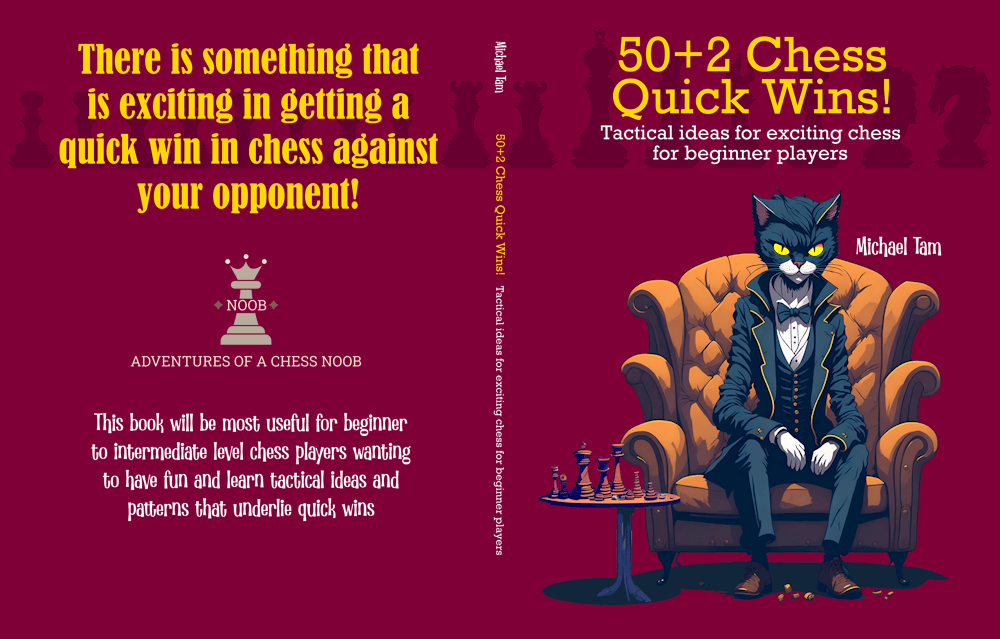
Wayward Queen Attack? | CRUSH with Kiddie Countergambit! Child's play! 😏
#waywardqueen #kiddie #countergambit #tactics #romantic #doublecheck
At the time of writing, my new book Become a Chess Assassin! has only been released for a couple of days, but I’ve been really pleased with how well it’s been selling! In fact, it’s currently the #1 Best Seller for chess books in Amazon Australia! 🥳🎊🎉

![]()
The book is a celebration of Romanticism in chess and so, it seems very fitting that I played this unrated game against Random Noob earlier today! I had the Black pieces and White led with the Wayward Queen Attack (1. e4 e5 2. Qh5).
Now, I’ve written and spoken about the Wayward Queen Attack (WQA) before. The most accurate response is that we “must” defend against the queen’s attack on our e5-pawn and thus, we should develop our queen’s knight (2… Nc6). After White plays (3. Bc4), lining up a Scholar’s Mate, we then kick back White’s queen with (3… g6). I cover the line in the video above, but also in my previous article on how to play against the “determined” Wayward Queen Attack player.
However, one of the things is that the “determined” WQA player at the intermediate level may well outplay you as they’ve studied and learnt the most accurate lines! Technically, the WQA isn’t bad for White from the perspective of accuracy.
Today, in the spirit of Romanticism, I decided to try something different, the Kiddie Countergambit with (2… Nf6)!

![]()
In essence, I’m giving up my e5-pawn as a gambit! It is commonly stated that this is unnecessary as (2… Nc6) preserves the pawn. This is of course true. However, notably, Stockfish doesn’t evaluate the Kiddie Countergambit as mistake! In fact, the evaluation barely changes [-0.3 → -0.1] despite the loss of material after (3. Qxe5+)!
When we look at the Lichess community database, the Kiddie Countergambit is the response to the WQA that has the best win likelihood for Black (White 46% vs Black 50%). It’s also been argued that it might be the psychologically correct move! Why? It’s a Romantic sacrifice that changes the dynamic of the game. Rather than playing into White’s preparation, the sacrifice of the pawn creates a semi-opened e-file, allows for rapid development as (3… Be7!) blocks the check and we’re ready to short castle, and we’re now in the position to chase and counterattack White’s queen without giving them the “tactical resource” of having a Scholar’s Mate lurking as a background threat!
On turn 4, Black has several options. I played (4… Nc6) to set the tone; I’m going to aggressively pursue White’s queen with development to capture the initiative, both in actuality, and psychologically. 😏 The other equally good moves are d5 and short castling, and the move order is flexible.
White made a correct backward queen move (5. Qf4) and at this point, I knowingly played an inaccurate and speculative “probing” move (5… Bd6?!). My goal was to gauge White’s psychological mindset. The correct response for White wasn’t necessarily difficult to find (6. e5), pressing forward with their pawn and a seeming fork of my f6-knight and d6-bishop. However, they made yet another hesitant retreating move of their queen (6. Qe3) and I suspected that their “attacking spirit” had been broken!
As I had them on the run, I pressed forward with another speculative attack, this time with my knight (6… Nb4?!), which was threatening Nxc2+, a Family Fork! This wasn’t an easy position for White to navigate, and the most accurate moves were “ugly”: Na3 or Kd1 to defend the c2-pawn. Instead, White moved their queen yet again, this time relegating it to guard duty with (7. Qb3?!).
Now in the early middlegame, I didn’t play the most accurate moves, but temporarily paused my attack to castle my king, and missed a devious tactic on turn 9. White had played (9. e5?) with the fork, and I responded with (9… Qe7?) pinning the e-pawn to their king. There’s a very tricky line starting with (9… Bxe5!) seemingly hanging the b4-knight. However, after White captures the knight (10. Qxb4), Black has (10… Re8) and the threat of the discovered check allows Black the step of tempo to recapture a piece, and potentially win White’s queen if they are careless! See the PGN and video.
Although I didn’t see this specific line, I saw another tactic that also made use of a discovered check! On turn 11, White pushed forward their knight to attack my queen (12. Nd5??), blundering [-M2]. The logic seemed sound; if I moved my knight to give a discovered check by my queen down the e-file, their knight would capture my queen… right?
Unfortunately for White, they didn’t see my plan! In response, I had (12… Nxf3+!); double checks make the impossible, possible! Although both my knight on f3 and my queen on e7 were hanging, revealing the discovered double check meant that neither piece could be captured! Against a double check the king must move.
Even the laziest king flees wildly in the face of a double check.
— Aron Nimzowitsch (1947), in My System
![]()
Having moved their queen so many times in the opening, White had little development, and all their remaining pawns were still on their second rank. White’s king had only a single legal move, sliding their king to the queen’s seat (13. Kd1). My queen then flew down the fully opened e-file, delivering back rank checkmate from the white king’s throne with (13… Qe1#)! A beautiful Romantic finish!
Game: https://www.chess.com/analysis/library/3WAotGJ1a6
![]()




